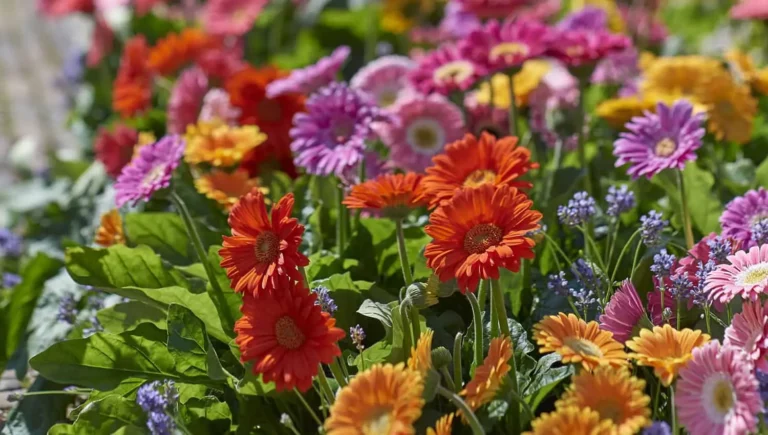Gerbera daisies are a stunning addition to any garden or floral arrangement with their bright, vivid colors that can make them appear almost unreal (even more so than Dahlias). As part of the Aster family, which includes sunflowers, these daisies originated from South Africa and have since been hybridized for optimal beauty. While they are tender perennials in most parts of the United States, Gerberas are treated as annuals in colder winter zones without winter protection.
Most popular Gerbera varieties:
- Everlast
- Garden Jewels
- Festival
- Garvinea Sweet
- Garvinea
Care
It’s crucial to provide the right growing environment, which includes pairing them with plants that bring out their bold colors, deadheading spent blooms, and removing clustered center leaves if the plant gets excessively bushy. Additionally, it’s essential to harvest Gerbera daisies when fully opened but with a tight center and to avoid overwatering, which can shorten their display time.
- Soil: start with rich, organic, and well-draining soil with a pH level between 5.5 and 6.5. Levels higher or lower than this range may cause yellow stripes or black spots on the leaves.
- Light: Gerbera daisies need full sun but don’t tolerate intense heat, so it’s best to plant them in an area with afternoon shade if you live in a hot climate. Avoid planting them near structures that reflect heat onto the plant.
- Water: Gerbera daisies need regular watering, around 1 inch per week, but water only when the soil has dried an inch or two below the surface. During hot, dry spells or when first getting established, they may need more frequent watering, while overwintered daisies go dormant and will only need light watering once a month.
- Temperature: Gerberas prefer to be kept at a cool, but not cold, temperature of around 45 to 50 degrees Fahrenheit.
Propagation
You can grow Gerbera daisies from seeds pretty easily, but the most popular way to go is propagation by division or by cuttings. For division, just usie a sterilized sharp knife or pruning snips, new soil, and a new, clean pot with a drainage hole. Then dig out the flower and cut through the roots to separate the root ball into two parts. After this, you can replant each part in its permanent location using a soil type similar to its current soil. Oh, and don’t forget to water each division thoroughly!
For propagating by cuttings in the summer, use sterilized pruning snips to take cuttings from the base or side shoots of the Gerbera plant, dip the cut end in rooting hormone to help develop roots faster, plant in fresh soil, and water when the substrate is dry to the touch.
Pruning
While low-maintenance, proper pruning is vital for optimal health. Start in late summer or early fall, removing faded, diseased, or damaged flowers and stems.
Trim back leggy or scraggly stems to promote fuller growth. Shape the plant by trimming long or misplaced stems. Prune in late winter or early spring for best results.
After pruning, deeply water and fertilize with a balanced high-nitrogen fertilizer. Regular pruning ensures thriving Gerbera daisies with abundant, healthy blossoms.
Common Pests
Gerbera plants are perennials in hardiness zones 8-11, but they are annuals in most of North America, except for the southern and western regions where they can be expected to re-bloom every year.
Where do gerbera daisies grow best?
Gerberas prefer sunlight but not intense heat, and can be grown in full sun in cooler temperatures. In moderate climates, they should be planted in areas with dappled shade or morning sun and afternoon shade.
Are Gerberas toxic to pets?
Thankfully, gerberas are non-toxic to pets and humans.
Do gerberas grow well in pots?
Yes, Gerberas can grow well in pots as long as the pot is large enough and has good drainage. They are well-suited for container gardening and can make a colorful statement in a porch or balcony.
Do gerberas like lots of water?
Gerberas like regular watering, but not too much. Overwatering can lead to root rot and other issues. As a general rule, water gerberas when the soil has dried an inch or two below the surface.
